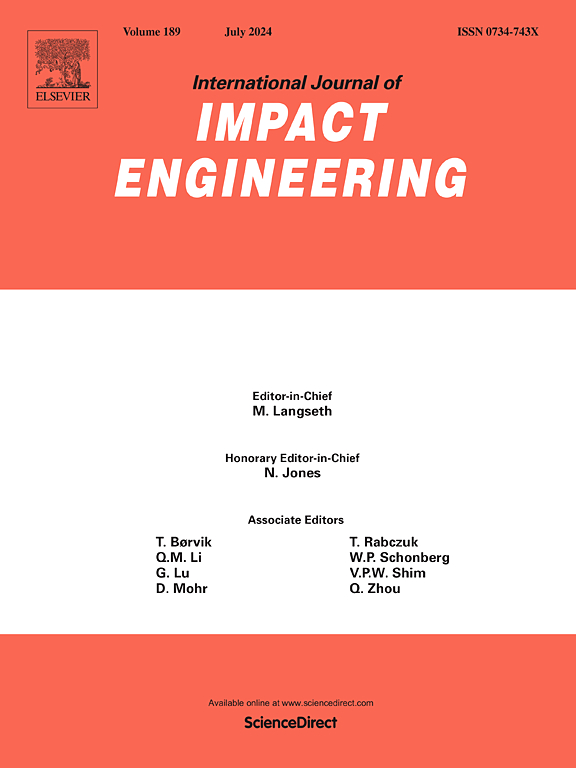Rate-dependent tensile failure behavior of 2D triaxially braided composites: Experimental characterization and Meso-FE simulation
IF 5.1
2区 工程技术
Q1 ENGINEERING, MECHANICAL
International Journal of Impact Engineering
Pub Date : 2025-06-20
DOI:10.1016/j.ijimpeng.2025.105433
引用次数: 0
Abstract
As two-dimensional triaxially braided composites (2DTBC) are increasingly employed in aerospace applications and anti-impact structures, it is important to study their dynamic mechanical behavior. In this work, the dynamic tensile behaviors of dogbone specimens with different fabric layers were investigated by utilizing high-speed imaging and an electromagnetic split Hopkinson bar (E-SHB) system. A full-scale meso-scale finite element (FE) model established to simulate the tensile failure behavior under different loading rates shows high consistency with the experimental results in its predictions of the stress-strain response and progressive damage behavior. Through examination of the effect of number of fabric layers on the quasi-static and dynamic mechanical behavior, specimen with multiple layers was concluded to be suitable for representing the dynamic tensile behavior of 2DTBC. Analysis and revelation of rate-dependent performance was conducted based on two-layer specimens utilizing both the test data and simulation results. The transverse failure mode was observed to transform from intra-yarn fracture under quasi-static loads to fiber breakage under dynamic loads for a reduced free-edge effect. The rate strengthening effect is attributed to the enhanced interface and matrix properties, ultimately resulting higher tensile properties at higher loading rates. Thickness effect under dynamic loads are investigated by simulation, and the incomplete fiber breakage damage as well as inadequate properties are again revealed in single-layer specimen. The findings of this study offer valuable insights for understanding the strain-rate behavior and thickness-dependent behavior of 2DTBC, thereby providing valuable knowledge for designing structures with better impact resistance.
二维三轴编织复合材料的速率相关拉伸破坏行为:实验表征和细观有限元模拟
随着二维三轴编织复合材料(2DTBC)越来越多地应用于航空航天和抗冲击结构中,研究其动态力学行为具有重要意义。利用高速成像技术和电磁分裂霍普金森杆(E-SHB)系统,研究了不同织物层数的狗骨试件的动态拉伸行为。建立了模拟不同加载速率下拉伸破坏行为的全尺寸细观有限元模型,其对应力-应变响应和渐进损伤行为的预测与试验结果具有较高的一致性。通过考察织物层数对2DTBC准静态和动态力学行为的影响,认为多层试样适合代表2DTBC的动态拉伸行为。利用试验数据和仿真结果,对两层试件的速率相关性能进行了分析和揭示。观察到横向破坏模式由准静态载荷下的纱线内部断裂转变为动态载荷下的纤维断裂,减少了自由刃效应。速率强化效应归因于界面和基体性能的增强,最终在更高的加载速率下获得更高的拉伸性能。通过模拟研究了动荷载作用下的厚度效应,在单层试件中再次出现纤维断裂不完全损伤和性能不充分的现象。本研究结果为理解2DTBC的应变率行为和厚度依赖行为提供了有价值的见解,从而为设计具有更好抗冲击性能的结构提供了有价值的知识。
本文章由计算机程序翻译,如有差异,请以英文原文为准。
求助全文
约1分钟内获得全文
求助全文
来源期刊

International Journal of Impact Engineering
工程技术-工程:机械
CiteScore
8.70
自引率
13.70%
发文量
241
审稿时长
52 days
期刊介绍:
The International Journal of Impact Engineering, established in 1983 publishes original research findings related to the response of structures, components and materials subjected to impact, blast and high-rate loading. Areas relevant to the journal encompass the following general topics and those associated with them:
-Behaviour and failure of structures and materials under impact and blast loading
-Systems for protection and absorption of impact and blast loading
-Terminal ballistics
-Dynamic behaviour and failure of materials including plasticity and fracture
-Stress waves
-Structural crashworthiness
-High-rate mechanical and forming processes
-Impact, blast and high-rate loading/measurement techniques and their applications
 求助内容:
求助内容: 应助结果提醒方式:
应助结果提醒方式:


